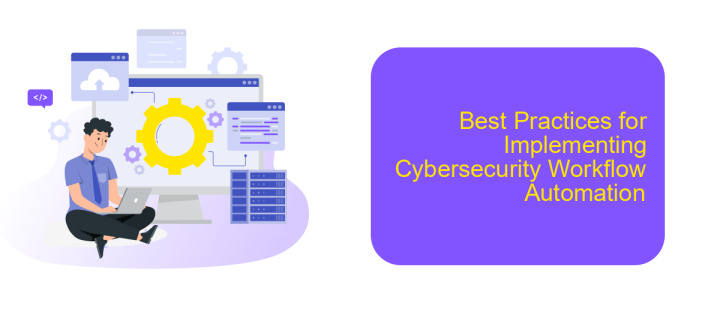Cyber Security Workflow Automation
In today's digital age, cyber security workflow automation is becoming essential for organizations to protect their sensitive data and systems. By automating repetitive tasks, companies can enhance their security posture, reduce human error, and respond to threats more efficiently. This article explores the benefits, implementation strategies, and key considerations for integrating automated workflows into your cyber security operations.
What is Cybersecurity Workflow Automation?
Cybersecurity Workflow Automation refers to the use of technology to streamline and enhance the efficiency of security processes. By automating repetitive and time-consuming tasks, organizations can better allocate their resources to focus on more critical aspects of cybersecurity. This leads to faster response times, reduced human error, and improved overall security posture.
- Automated threat detection and response
- Incident management and reporting
- Security policy enforcement
- Integration with other security tools
One of the key components of cybersecurity workflow automation is the integration of various security tools and platforms. Services like ApiX-Drive facilitate these integrations by connecting different applications and automating data transfers between them. This ensures that all security systems work cohesively, providing a more robust defense against cyber threats. By leveraging such services, organizations can achieve a higher level of automation and efficiency in their cybersecurity operations.
Benefits of Automating Cybersecurity Workflows

Automating cybersecurity workflows offers numerous benefits, including enhanced efficiency and reduced human error. By automating repetitive tasks such as threat detection, incident response, and vulnerability management, organizations can significantly decrease the time required to address security issues. This not only improves overall security posture but also allows cybersecurity professionals to focus on more strategic and complex tasks, thereby maximizing the use of their skills and expertise.
Furthermore, automation facilitates better integration of various security tools and platforms. Services like ApiX-Drive enable seamless integration between different applications, ensuring that data flows smoothly and securely across systems. This integrated approach helps in creating a cohesive security framework, making it easier to monitor, detect, and respond to threats in real-time. Additionally, automation helps in maintaining compliance with industry standards and regulations by ensuring that all security protocols are consistently followed, thus mitigating risks and enhancing organizational resilience.
Challenges of Implementing Cybersecurity Workflow Automation

Implementing cybersecurity workflow automation presents several challenges that organizations must address to ensure effective and secure operations. These challenges range from technical complexities to human factors, and overcoming them is crucial for a successful deployment.
- Integration Issues: Seamlessly integrating various cybersecurity tools and systems can be complex. Services like ApiX-Drive can help by providing robust integration solutions that simplify connecting disparate systems.
- Data Privacy Concerns: Automating workflows often involves handling sensitive data, raising concerns about data privacy and compliance with regulations.
- Skill Gaps: There is often a shortage of skilled professionals who can design, implement, and manage automated cybersecurity workflows effectively.
- Scalability: Ensuring that automated workflows can scale with the organization's growth is a significant challenge.
- Cost: The initial investment in automation tools and technologies can be high, and organizations must weigh these costs against the potential benefits.
Addressing these challenges requires a strategic approach, leveraging advanced integration services like ApiX-Drive, investing in training for cybersecurity professionals, and ensuring compliance with data privacy regulations. By doing so, organizations can effectively implement cybersecurity workflow automation and enhance their overall security posture.
Best Practices for Implementing Cybersecurity Workflow Automation

Implementing cybersecurity workflow automation can significantly enhance your organization's security posture by streamlining processes and reducing human error. To ensure successful implementation, it is crucial to follow best practices that align with your security goals and operational needs.
Begin by identifying the specific workflows that would benefit most from automation. This involves assessing current processes to pinpoint inefficiencies and potential security risks. Once identified, prioritize these workflows based on their impact and feasibility for automation.
- Define clear objectives and metrics for success.
- Choose reliable automation tools and platforms.
- Integrate with existing security systems and protocols.
- Ensure regular updates and maintenance of automated workflows.
- Provide comprehensive training for staff on automated processes.
Utilizing integration services like ApiX-Drive can streamline the process of connecting various security tools, ensuring seamless data flow and real-time threat detection. By adhering to these best practices, you can create a robust and efficient cybersecurity workflow automation framework that enhances your organization's overall security posture.


The Future of Cybersecurity Workflow Automation
The future of cybersecurity workflow automation is poised to transform the way organizations handle security threats. As cyber-attacks become more sophisticated, the need for automated solutions that can quickly identify and mitigate risks is paramount. Advanced machine learning algorithms and artificial intelligence will play a critical role in predicting and preventing potential breaches. These technologies will not only streamline threat detection but also enhance response times, reducing the overall impact of security incidents.
Integration of various cybersecurity tools and platforms will become more seamless, thanks to services like ApiX-Drive. This service allows for easy integration of different applications and systems, enabling a more cohesive and efficient security infrastructure. By automating workflows and integrating disparate systems, organizations can ensure that their cybersecurity measures are always up-to-date and capable of adapting to new threats. As these technologies continue to evolve, the future of cybersecurity workflow automation will undoubtedly lead to more robust and resilient security strategies.
FAQ
What is Cyber Security Workflow Automation?
How can automation improve my cybersecurity posture?
What tasks can be automated in a cybersecurity workflow?
How do I integrate automation tools into my existing cybersecurity infrastructure?
Is it safe to rely on automated cybersecurity solutions?
Strive to take your business to the next level, achieve your goals faster and more efficiently? Apix-Drive is your reliable assistant for these tasks. An online service and application connector will help you automate key business processes and get rid of the routine. You and your employees will free up time for important core tasks. Try Apix-Drive features for free to see the effectiveness of the online connector for yourself.

